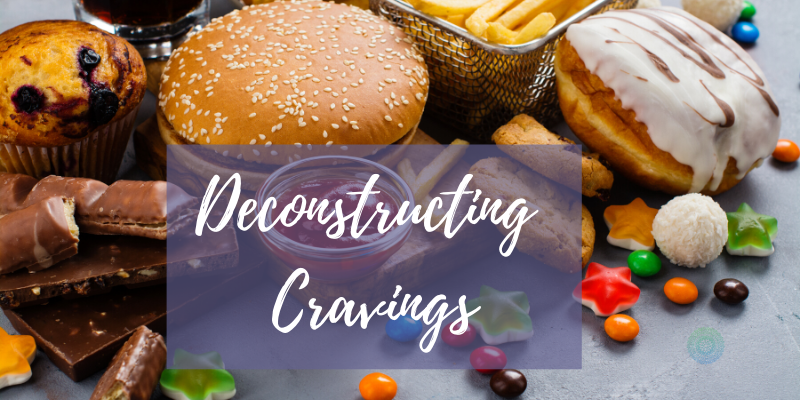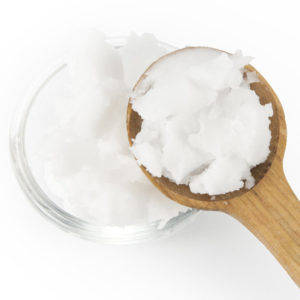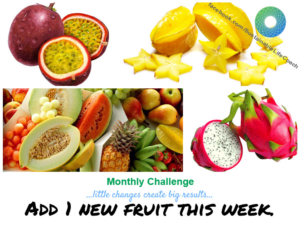Deconstructing cravings seems like an uphill battle. Mixed signals create chaos in relationships. As they do when it comes to cravings.
Deconstructing your cravings is not that difficult. Understanding that a strong craving is not a signal from the stomach that you’re hungry, but messaging from your brain is an excellent place to start.
Hunger is all about your survival mechanism, but cravings are all about your body communicating with you. From there it’s easy to remember that your brain is looking for something specific. Not just the flavor experience, but fuel to help your body thrive.
What Can Cause Food Cravings?
Below is a chart of all the common food cravings, flavor cravings and eating habits you may experience, the reason behind each craving and all the foods you can eat to fix the craving!
This chart was first published by Colleen Huber on her website and then in her book “CHOOSE YOUR FOODS: Like Your Life Depends on Them, by Colleen Huber, NMD” in 2007.
| Craving this: | Reason is: | Restore with this: |
| COMMON FOOD | ||
| Cheese | Essential Fatty Acids deficiency | Omega 3′s (EPA and DHA)– Flax oil, ground flaxseeds, chia seeds, walnuts |
| Calcium deficiency | Sesame seeds/ tahini, broccoli, kale, legumes, mustard and turnip greens | |
| Pasta, white bread, pastries | Chromium deficiency | Onion, romaine lettuce, tomato, cinnamon, grapes, apples, sweet potato |
| Bread and toast | Nitrogen deficiency | Foods containing proteins, i.e.. Green leafy veg, nuts, seeds, legumes, grains |
| Red meat | Iron deficiency | Beans, legumes, unsulphured prunes, figs+ other dried fruit, seaweed, spinach, cherries, Vitamin C for iron absorption |
| Popcorn | Stress hormone fluctuations | Meditation, breathing exercises, exercise, leafy greens, vitamin B and C |
| Crisps | Chloride deficiency | Celery, olives, tomato, kelp, Himalayan sea salt |
| Essential Fatty Acids deficiency | Omega 3′s (EPA and DHA)– Flax oil, ground flaxseeds, chia seeds, walnuts | |
| FLAVOR | ||
| Burned Food | Carbon deficiency | Fresh fruits |
| Acid foods | Magnesium deficiency | Raw cacao nibs/beans/powder, whole grains, beans, nuts, seeds, greens, fruit |
| Salty Foods | Chloride deficiency | Celery, olives, tomato, kelp, Himalayan sea salt |
| Stress hormone fluctuations | Meditation, breathing exercises, exercise, leafy greens, vitamin B and C | |
| SWEETS | ||
| Chocolate | Magnesium deficiency | Raw cacao nibs/beans/powder, whole grains, beans, nuts, seeds, greens, fruit, magnesium |
| Soda, fizzy drinks | Calcium deficiency | Sesame seeds/ tahini, broccoli, kale, legumes, mustard and turnip greens |
| General sweets | Hypoglycemia (low blood sugar) | Fruit, high fibre foods (beans, legumes), complex carbs (grains), chromium (cinnamon) |
| Tryptophan deficiency | Spirulina, pumpkin/sesame/sunflower seeds, raw cacao, oatmeal, sweet potato, spinach, raisins | |
| Chromium deficiency | Onion, romaine lettuce, tomato, cinnamon, grapes, apples, sweet potato | |
| Sulphur deficiency | Cruciferous vege (kale, cabbage, etc), cranberries, horseradish, asparagus, carob powder, garlic, onion | |
| Phosphorus deficiency | Whole grains, pinto beans, pumpkin seeds, brazil nuts, lentils | |
| STIMULANTS | ||
| Coffee or black tea | Sulphur deficiency | Cruciferous vege (kale, cabbage, etc), cranberries, horseradish, asparagus, carob powder, garlic, onion |
| Iron deficiency | Beans, legumes, unsulphured prunes, figs+ other dried fruit, seaweed, spinach, cherries, Vitamin C for iron absorption | |
| NaCl (salt) deficiency | Himalayan salt, Apple Cider vinegar, kombucha | |
| Phosphorous deficiency | Whole grains, pinto beans, pumpkin seeds, brazil nuts, lentils | |
| Alcohol, recreational drugs | Calcium deficiency | Sesame seeds/ tahini, broccoli, kale, legumes, mustard and turnip greens |
| Glutamine deficiency | Cabbage, beetroot, beans, spinach, parsley, vegetable juice, bone broth | |
| Protein deficiency | Green leafy vegetable, nuts, seeds, legumes, grains, beans | |
| Potassium deficiency | Citrus fruits, bitter green leafy veg, banana, tomato, pineapple, black olives, seaweeds | |
| Avenin deficiency | Oatmeal, granola, cereals, whole grains | |
| Tobacco | Silicon deficiency | Horsetail herb, nuts, seeds, oats, millet, barley, onions, whole wheat, beetroot. Avoid refined starches |
| Tyrosine deficiency | Fruits (esp. avocado and banana), whole grains, oats, legumes, beans, nuts, seeds, Vitamin C, vegetables | |
| EATING HABITS | ||
| Lack of appetite | Chloride deficiency | Celery, olives, tomato, kelp, Himalayan salt |
| Thiamine (Vitamin B1) deficiency | Whole grains, peanuts, seeds, beans, green and yellow vegetables | |
| Niacin (Vitamin B3) deficiency | Peanuts, sunflower seeds, wheat bran and wheat germ | |
| Manganese deficiency | Walnuts, almonds, pecans, whole grains, green leafy veges, pineapple, blueberries | |
| Often overeating | Tryptophan deficiency | Spirulina, pumpkin/sesame/sunflower seeds, raw cacao, oatmeal, sweet potato, spinach, raisins |
| Tyrosine deficiency | Fruits (esp. Avocado and banana), whole grains, oats, legumes, beans, nuts, seeds, Vitamin C, veges | |
| Silicon deficiency | Horsetail herb, nuts, seeds, oats, millet, barley, onions, whole wheat, beetroot. Avoid refined starches | |
| Often snacky | No balanced diet, missing nutrients | Do a detox, substitute junk food for healthy meals |
| MORE BIZARRE | ||
| Crunching on ice | Iron deficiency | Beans, legumes, unsulphured prunes, figs+ other dried fruit, seaweed, spinach, cherries, Vitamin C for iron absorption |
| Laundry starch | Iron deficiency | Beans, legumes, unsulphured prunes, figs+ other dried fruit, seaweed, spinach, cherries, Vitamin C for iron absorption |
| Cigarette butts | Iron deficiency | Beans, legumes, unsulphured prunes, figs+ other dried fruit, seaweed, spinach, cherries, Vitamin C for iron absorption |
Taming the Cravings
Food cravings are a major roadblock for people trying to maintain a healthy weight or switch to a more healthful diet. Luckily, there are some simple steps to take to handle these cravings.
Reducing stress levels
Pregnant women often experience strong cravings. This may be due to hormonal changes, which are thought to cause some food cravings.
Stress and emotional eating can influence a variety of health issues. Feeling stressed may promote emotional eating and cravings for comfort foods.
One study – Trusted Source found that stressed women are more prone to cravings for sweets than women without stress. Eating due to stress may also cause weight gain and a larger hip circumference.
Stress may also cause weight gain on its own, without extra food cravings. Stress results in higher levels of cortisol, the stress hormone, which may promote belly fat.
Drinking Plenty of Water
Hunger and thirst can produce very similar sensations in the mind, causing it to become confused. One of the easiest ways to reduce food cravings is to make sure the body is hydrated throughout the day.
Drinking plenty of water helps clean out toxins from the body, which may also benefit a person’s overall well-being.
Getting Enough Sleep
A 2013 study found that not getting enough sleep could alter the body’s hormonal balance. This imbalance contributes to overeating and weight gain.
The researchers noted that when the sleep-deprived participants switched to an adequate sleep schedule, they lost weight, which indicates that their hormones were brought back into balance.
Eating Enough Protein
A healthful diet should contain plenty of lean sources of protein, as they may help reduce cravings.
A study in the journal Obesity found that overweight men were able to reduce their cravings by up to 60 percent by getting 25 percent of their daily calorie intake from protein.
The same study found that a high protein diet helped reduce the desire for nighttime snacks by 50 percent.
Chewing Gum
Chewing gum keeps the mouth busy and may help reduce both sweet and salty cravings.
One study found a small but significant difference in sweet and salty snack consumption among people who chewed gum and those who did not. Those who chewed gum rated themselves less hungry, had fewer cravings for snacks, and felt fuller than those who did not chew gum.
Changing the Scenery
Changing habits, such as stopping at the park instead of picking up fast food on the way home, can help to reduce cravings in the long-term.
Replacing habits can be difficult, and some food cravings may be due to long-term habits. For instance, if someone gets fast food on their way home from work every day, this practice may reinforce their cravings.
In situations like these, it is best to start new habits. This can be as easy as taking a new route home from work or stopping at the park for a quick walk instead.
For cravings at home, it may help to take a walk around the block, take a shower, or even call a friend. These things may help distract a person from their craving long enough for it to subside.
Avoiding Hunger
A healthful diet does not include frequent hunger pangs. In fact, under-eating can make food cravings worse.
When the body is very hungry, it may crave more calorie-dense foods than usual, including fried and processed foods.
Instead of waiting for intense feelings of hunger, it is better to have a regular pattern of meals and healthful snacks planned throughout the day to avoid potential cravings.
Controlling Portions
It can help to put this treat at the end of a healthful habit, such as going for a walk or completing an exercise routine.
For some people, completely avoiding the food they crave may make these cravings worse. This can lead to overeating or feeling miserable without that food. In this case, it may be better to satisfy the cravings with a small, portion-controlled treat.
If a person is prone to binge eating, a better option is to replace the craving altogether.
Did you recognize any food cravings that you experience in the chart above? Do you have your own questions, comments or feedback to add? Then leave your thoughts below!




